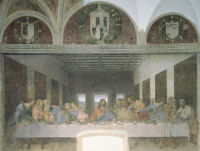Rule of Mathematics Click on the thumbnails to explore the trail
Read more about this trail (expand)
Leonardo believed that all things in nature were governed by mathematics. Mathematics was of supreme importance and expressed incontrovertible, universal truth. Knowledge of mathematics was a prerequisite for understanding the nature of all things. “Let no-one who is not a mathematician read my principles”, Leonardo said. Geometry and its actual or potential relationship to natural forms provided a suitably visual means for the exploration of mathematical “truths”.

- Enlarge
- Zoom & explore
- © SPSAE, Milano
Last Supper c1495-98
In Leonardo’s Last Supper, the rules of mathematical perspective have been deliberately manipulated in order to enhance the dramatic effect of the narrative.
Leonardo stated that the viewpoint of any perspective painting should be placed according to the eye-level of the spectator. But the vanishing point of the Last Supper is in an impossible position at more than twice the height of a man. Leonardo has also ignored his own rule that the ideal viewing distance should be “at least twenty times the greatest height and width of your work”. He appears to have done this because the result would have had a distorting effect, as the combined effect of the adjustments is the avoidance of a single, perfect viewing point so that the painting looks convincing from anywhere in the room.
Furthermore, although at first glance the space of the painting appears as an extension of the space of the refectory, the side walls of the painted room are not on the same plane as the walls of the refectory. And the coffered ceiling does not abut the cornice but continues upwards behind the lunettes.
In Leonardo's words
And as the geometrician reduces every area circumscribed by lines to square and every body to the cube; and arithmetic does likewise with its cube and square roots, these sciences do not extend beyond the study of continuous and discontinuous quantities…they do not deal with the quality of things which constitutes the beauty of the works of nature and the ornament of the world.
One of Leonardo’s most famous paintings, and famous during his own lifetime, the Last Supper is now but a shadow of its former self as it would have appeared on completion in 1497. A combination of the unorthodox painting techniques employed by Leonardo, the pervading dampness of the refectory wall and repeated programmes of restoration that began as early as 1517, have all contributed to the substantial deterioration of the painting.
However, the most recent campaign of restoration completed in 1999 seems to have halted the deterioration of the painting’s surface and brought to light the original colour of the work. Furthermore, previously unobserved details are now apparent, such as the wall-hangings and their patterns seen on the side walls of the room in which the “Last Supper” takes place and the objects on the table.
The coats of arms that appear in the lunettes above the painting indicate that the painting was not commissioned by the monks of Santa Maria delle Grazie, but by Ludovico Sforza, who was also the patron of the new choir of the church of Santa Maria delle Grazie, which was intended as a family mausoleum for Ludovico and his family. The fact that the Last Supper is described in glowing terms by Luca Pacioli in his Divina Proportione, dedicated to Ludovico Sforza in February 1498, indicates that the painting was probably completed some time in 1497.
Pacioli mentions how the painting describes the moment at which Christ announced, “One of you shall betray me” (Matthew 26:21).
- Medium Oil and tempera on plaster
- Size 460 x 880 cm
- Location Santa Maria delle Grazie












